Early-Stage Research to Characterize the Electrical Signal of Optically Stimulated Hydroponic Strawberries Using Machine Learning Techniques †
Abstract
1. Introduction
2. Materials and Methods
2.1. Hydroponic System
2.2. Electrical Signal Sensing System
2.3. Implementation of Machine Learning in Precision Agriculture
Machine Learning—Classification
3. Results and Discussions
3.1. Comparison of Models
3.2. Support Vector Machine (SVM)
3.3. Random Forest Model (RFM)
4. Discussion
5. Conclusions
Author Contributions
Funding
Institutional Review Board Statement
Informed Consent Statement
Data Availability Statement
Acknowledgments
Conflicts of Interest
References
- Ndung’u, R.; Kamweru, P.; Kirwa, A. Action and variation potential electrical signals in higher plants. Afr. J. Biol. Sci. 2021, 3, 1–18. Available online: https://ssrn.com/abstract=3771952 (accessed on 12 December 2024).
- Volkov, G.; Ranatunga, A. Plants as Environmental Biosensors. Plant Signal. Behav. 2006, 1, 105–115. [Google Scholar] [CrossRef] [PubMed]
- Davies, E. Electrical Signals in Plants: Facts and Hypotheses. In Plant Electrophysiology; Volkov, A.G., Ed.; Springer: Berlin/Heidelberg, Germany, 2006; pp. 407–422. [Google Scholar] [CrossRef]
- Vodeneev, V.; Akinchits, E.; Sukhov, V. Variation potential in higher plants: Mechanisms of generation and propagation. Plant Signal. Behav. 2015, 10, e1057365. [Google Scholar] [CrossRef] [PubMed]
- Samhita, V.; Prathyusha, K.; Kondaveeti, H. A Review on Plant Signal Processing. In Proceedings of the 2021 7th International Conference on Advanced Computing and Communication Systems (ICACCS), Coimbatore, India, 19–20 March 2021; pp. 124–128. [Google Scholar] [CrossRef]
- Ríos-Rojas, L.; Morales-Moraga, D.; Alcalde, J.; Gurovich, L. Use of plant woody species electrical potential for irrigation scheduling. Plant Signal. Behav. 2015, 10, e976487. [Google Scholar] [CrossRef] [PubMed]
- Volkov, G. Green plants: Electrochemical interfaces. J. Electroanal. Chem. 2000, 483, 150–156. [Google Scholar] [CrossRef]
- Volkov, A.; Markin, V. Active and Passive Electrical Signaling in Plants. Prog. Bot. 2015, 76, 143–176. [Google Scholar] [CrossRef]
- Cadosch, D.; Huang, P.; Damian, D.; Miyashita, S.; Aoyama, A.; Pfeifer, R. Attempt on plant machine interface. In Proceedings of the 2011 IEEE International Conference on Systems, Man, and Cybernetics, Anchorage, AK, USA, 9–12 October 2011; pp. 791–796. [Google Scholar] [CrossRef]
- Dolfi, M.; Colzi, I.; Morosi, S.; Masi, E.; Mancuso, S.; Del Re, E. Plant electrical activity analysis for ozone pollution critical level detection. In Proceedings of the 2015 23rd European Signal Processing Conference (EUSIPCO), Nice, France, 31 August–4 September 2015; pp. 2431–2435. [Google Scholar] [CrossRef]
- Brito, C. Different LED light intensity and quality change perennial ryegrass (Lolium perenne L.) physiological and growth responses and water and energy consumption. Front. Plant Sci. 2023, 14, 1160100. [Google Scholar] [CrossRef] [PubMed]
- Bantis, F.; Koukounaras, A. Impact of Light on Horticultural Crops. Agriculture 2023, 13, 828. [Google Scholar] [CrossRef]
- Abdouli, D. Effects of Monochromatic Light on Growth and Quality of Pistacia vera L. Plants 2023, 12, 1546. [Google Scholar] [CrossRef] [PubMed]
- Paradiso, R.; Proietti, S. Light-quality manipulation to control plant growth and photomorphogenesis in greenhouse horticulture: The state of the art and the opportunities of modern LED systems. J. Plant Growth Regul. 2022, 41, 742–780. [Google Scholar] [CrossRef]
- Jiang, C. Integrating omics reveals insights into tomato abaxial/adaxial leafy supplemental lighting. Front. Plant Sci. 2023, 14, 1118895. [Google Scholar] [CrossRef] [PubMed]
- Kobayashi, T.; Tabuchi, T. Tomato cultivation in a plant factory with artificial light: Effect of UV-A irradiation during the growing period on yield and quality of ripening fruit. Hortic. J. 2022, 91, 16–23. [Google Scholar] [CrossRef]
- Hanyu, H.; Shoji, K. Effects of blue light and red light on kidney bean plants grown under combined radiation from narrow-band light sources. Environ. Control Biol. 2000, 38, 13–24. [Google Scholar] [CrossRef][Green Version]
- Savini, G.; Neri, D.; Zucconi, F.; Sugiyama, N. Strawberry Growth and Flowering. Int. J. Fruit Sci. 2005, 5, 29–50. [Google Scholar] [CrossRef]
- Kadir, S.; Carey, E.; Ennahli, S. Influence of High Tunnel and Field Conditions on Strawberry Growth and Development. Hort Sci. 2006, 41, 329–335. [Google Scholar] [CrossRef]
- Lamont, W.; Orzolek, M.; Holcomb, E.; Crassweller, M.; Demchak, K.; Burkhart, E.; White, L.; Dye, B. Penn state high tunnel extension program. HortTechnology 2002, 12, 732–735. [Google Scholar] [CrossRef]
- Zhou, J.; Yuan, W.; Di, B.; Zhang, G.; Zhu, J.; Zhou, P.; Ding, T.; Qian, J. Relationship among Electrical Signals, Chlorophyll Fluorescence, and Root Vitality of Strawberry Seedlings under Drought Stress. Agronomy 2022, 12, 1428. [Google Scholar] [CrossRef]
- Trivellini, A. LED lighting to produce high-quality ornamental plants. Plants 2023, 12, 1667. [Google Scholar] [CrossRef] [PubMed]
- Konrad, K. Optogenetic Methods in Plant Biology. Annu. Rev. Plant Biol. 2023, 74, 313–339. [Google Scholar] [CrossRef] [PubMed]
- Torre, M.Z.; Sifuentes-Gallardo, C.; González-Ramírez, E.; Cruz-Dominguez, O.; Ortega-Sigala, J.; Díaz-Flórez, G.; Vargas, J.I.; Durán-Muñoz, H. Electrical Signal Characterization of Aloe vera Var. Chinensis Using Non-Parametric and Parametric Signal Analysis. Appl. Sci. 2025, 15, 1708. [Google Scholar] [CrossRef]
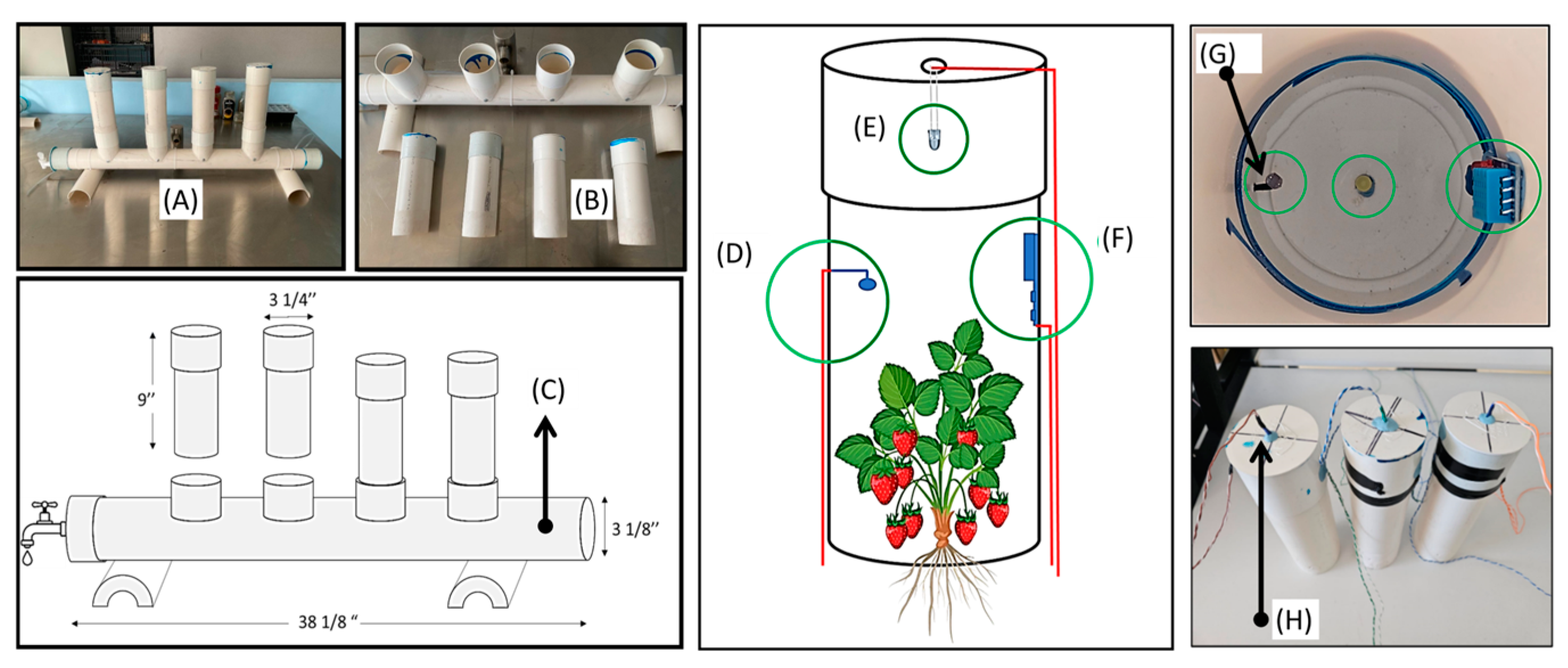
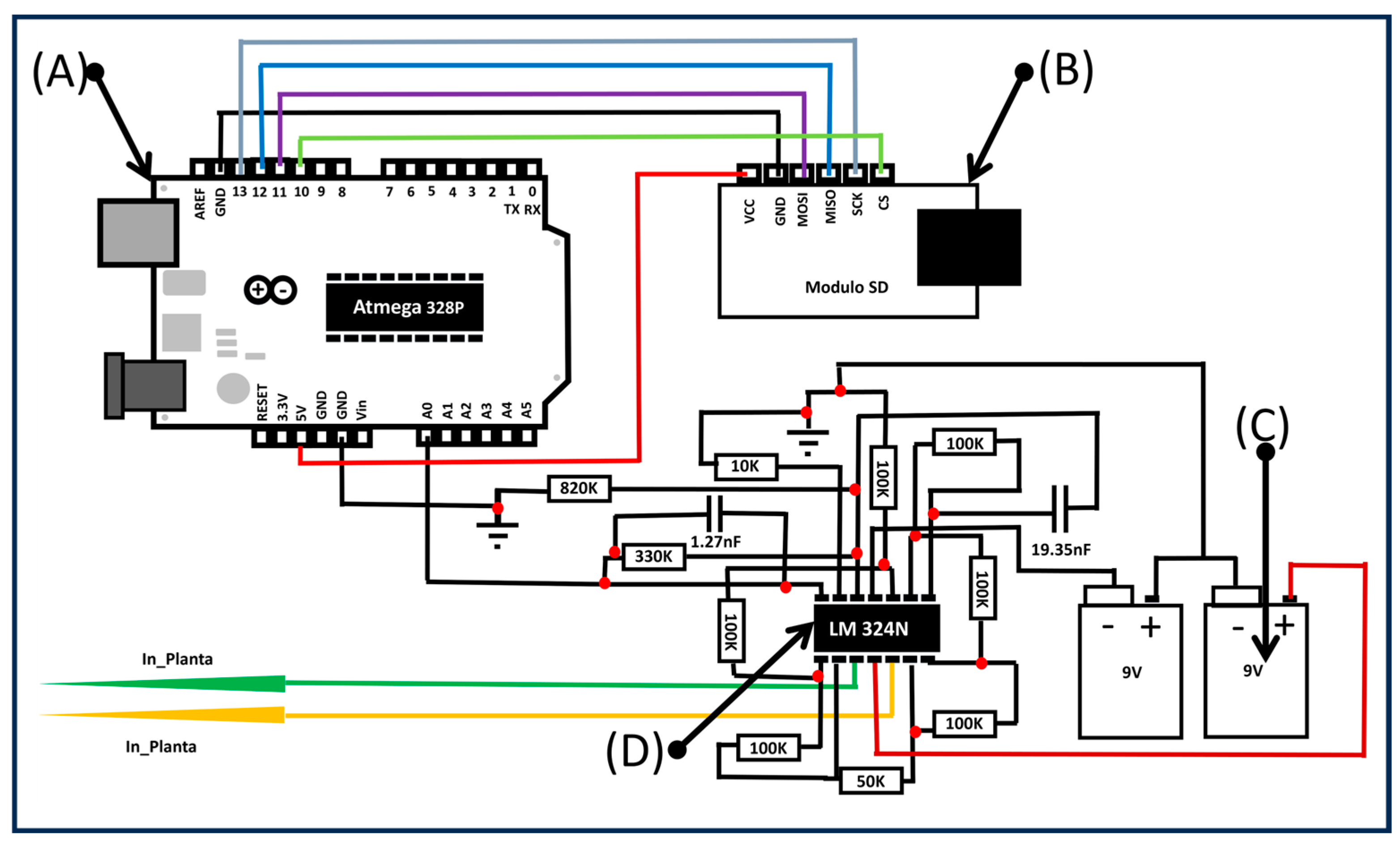
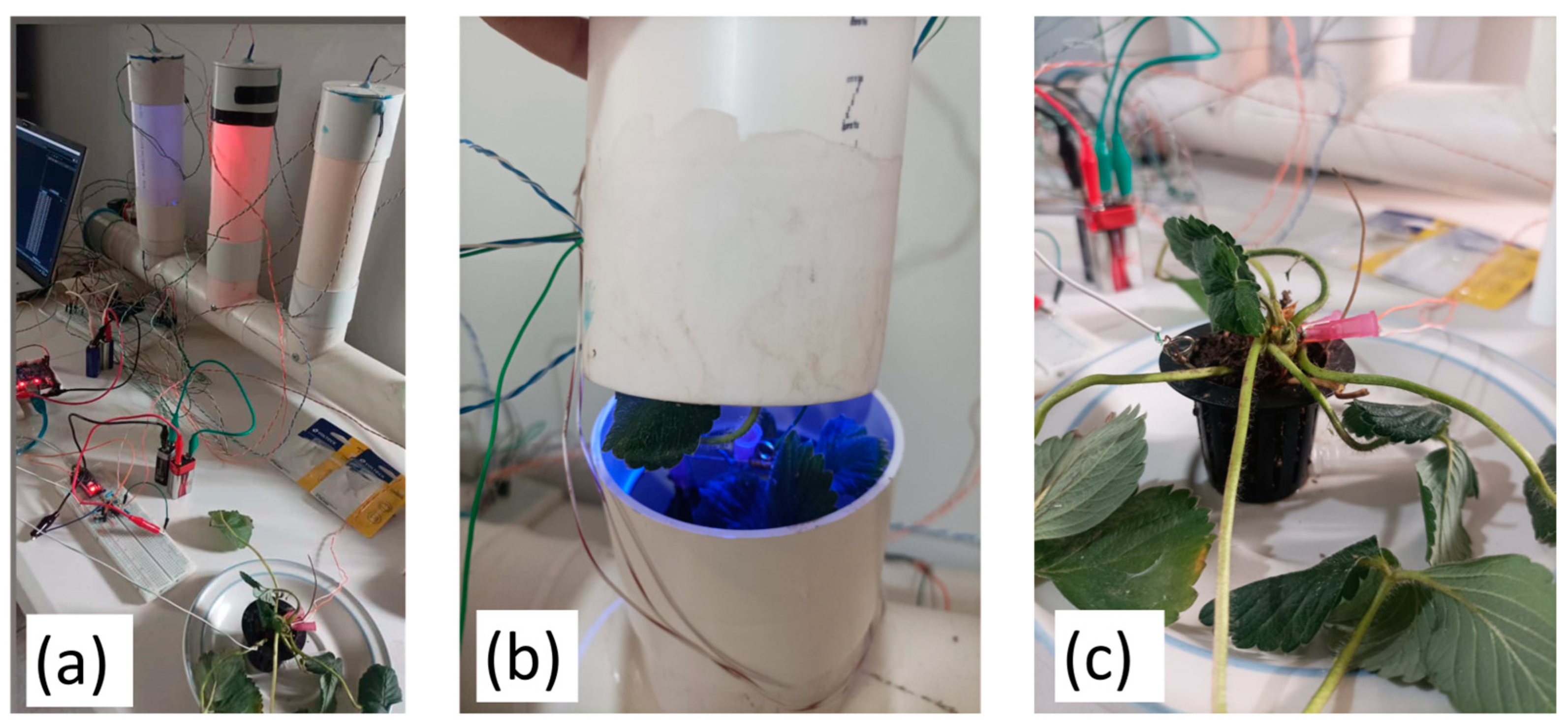
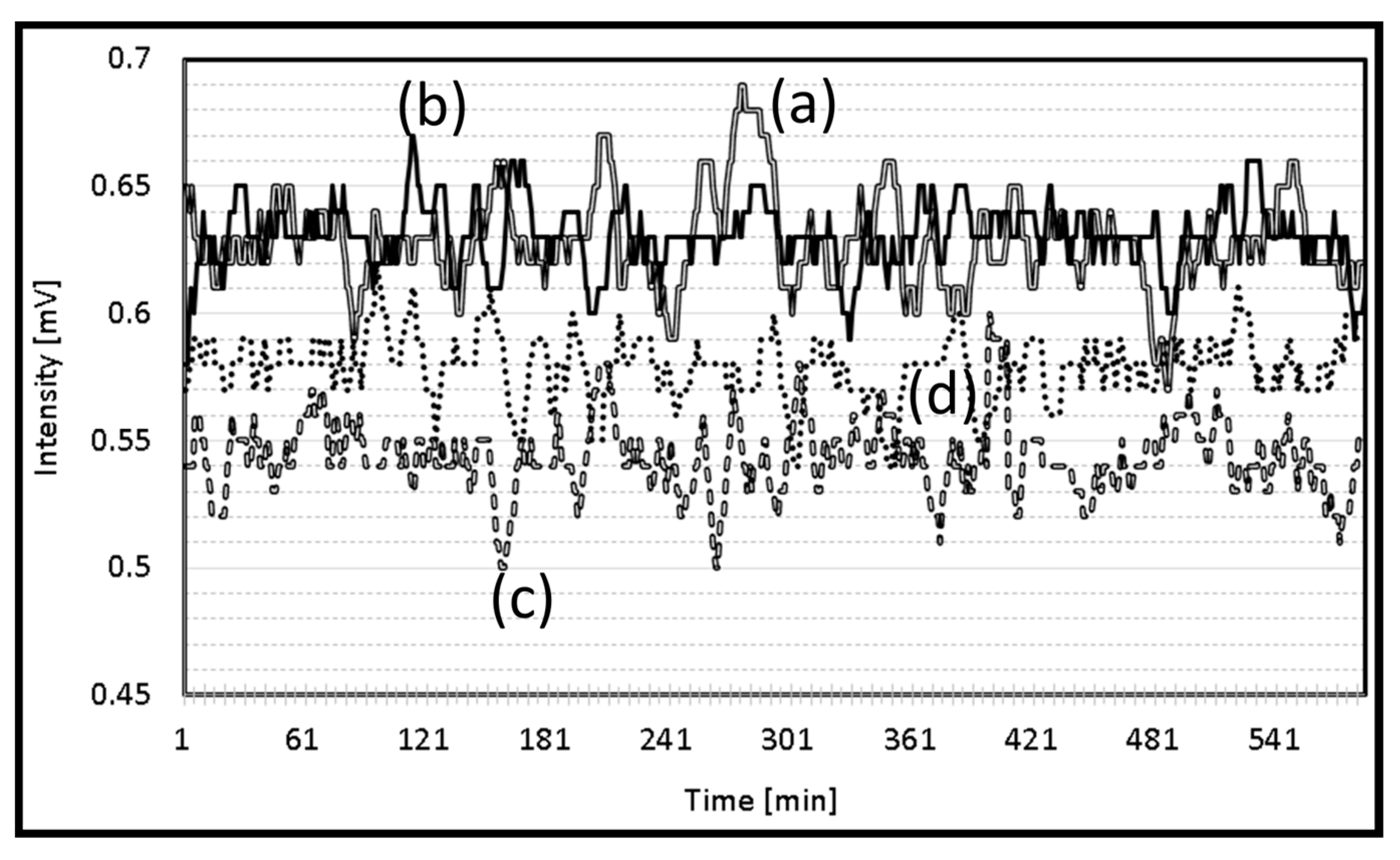

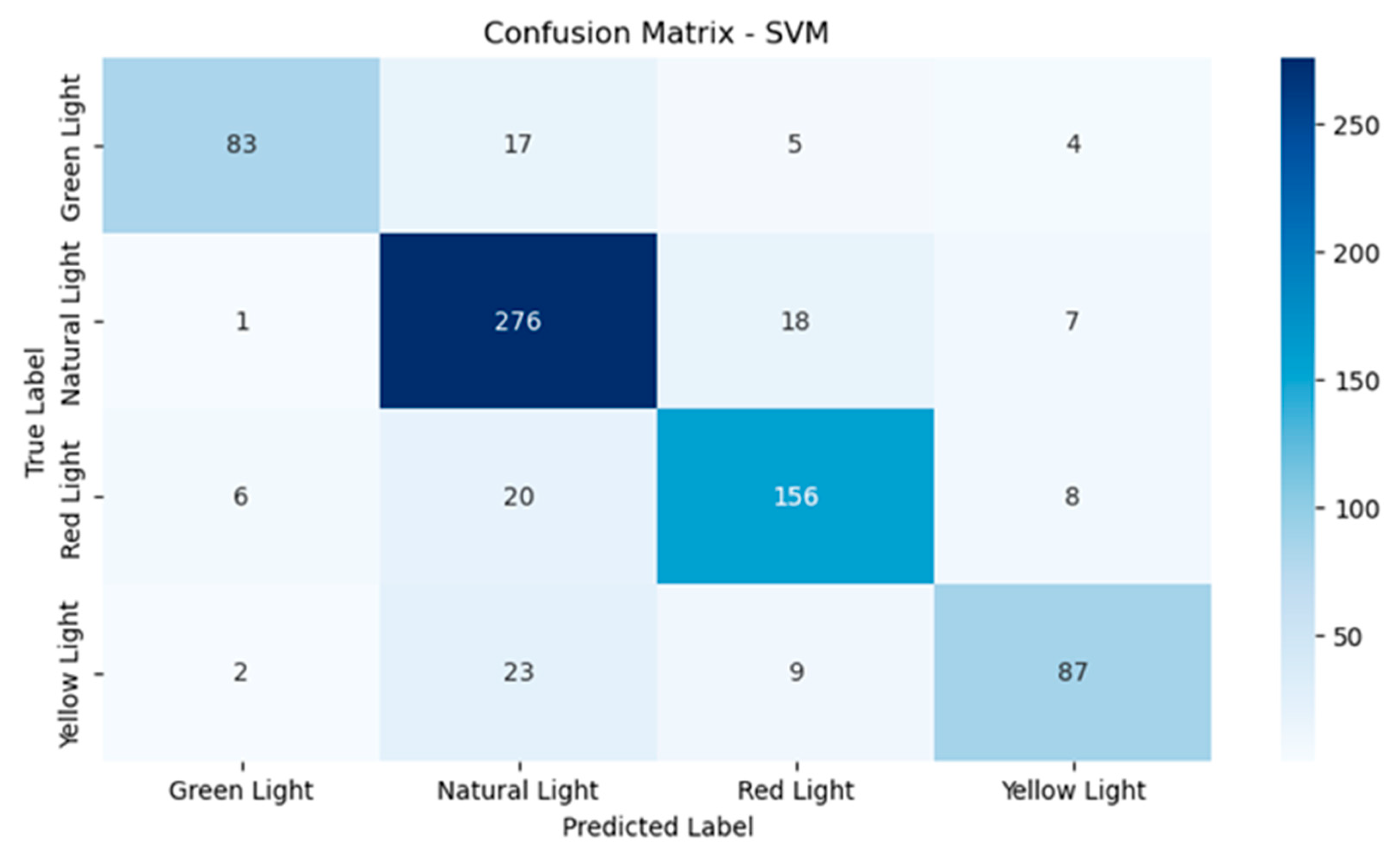

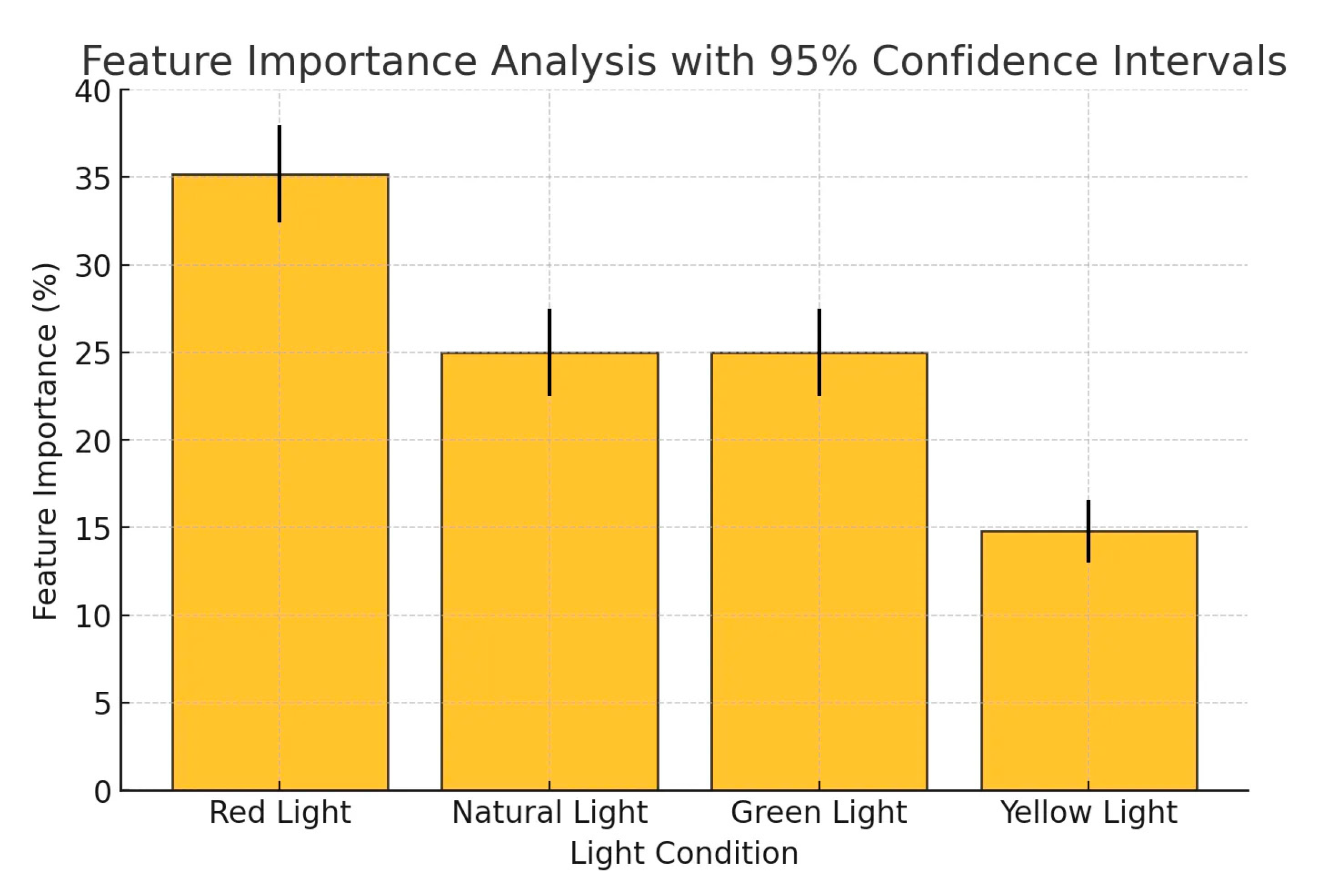
| LED | Luminous Intensity [mcd at 20 mA] | Dominant Wavelength [nm] at 20 mA |
|---|---|---|
| Red light | 40 | 635 |
| Yellow light | 9.8 | 587 |
| Green light | 45 | 520 |
| #include <SD.h> const int pin_analogico = A0; // Entrada de datos analogicos const int chipSelect = 8; // Pin de selección de la tarjeta SD int valor = 0; //inicializamos valores en cero float volt = 0.0; // inicializamos el valor del voltaje en cero // Parámetros del filtro pasa bandas const int numMuestras = 10; // Número de muestras para el filtro de media móvil float muestras[numMuestras] = {0}; // Buffer para almacenar las últimas muestras void setup() { Serial.begin(9600); // Inicializar la tarjeta SD if (SD.begin(chipSelect)) { Serial.println(“Tarjeta SD inicializada correctamente”); } else { Serial.println(“Error al inicializar la tarjeta SD”); return; } } | void loop() { valor = analogRead(pin_analogico); volt = valor * 5.0/1023.0; // Aplicar el filtro pasa bandas (media móvil) float suma = volt; for (int i = 0; i < numMuestras − 1; i++) { muestras[i] = muestras[i + 1]; suma += muestras[i]; } muestras[numMuestras − 1] = volt; float resultadoFiltro = suma / numMuestras; Serial.println(resultadoFiltro); // Guardar el resultado en el archivo en la tarjeta SD File dataFile = SD.open(“datos.txt”, FILE_WRITE); if (dataFile) { dataFile.println(resultadoFiltro); dataFile.close(); } else { Serial.println(“Error al abrir el archivo en la tarjeta SD”); } delay(1000); // Esperar antes de la próxima lectura } |
| SVM | Random Forest Model | |
|---|---|---|
| Accuracy | 0.83 | 0.88 |
| Precision (Macro Avg) | 0.84 | 0.88 |
| Recall (Macro Avg) | 0.80 | 0.87 |
| F1 Score (Macro Avg) | 0.82 | 0.88 |
Disclaimer/Publisher’s Note: The statements, opinions and data contained in all publications are solely those of the individual author(s) and contributor(s) and not of MDPI and/or the editor(s). MDPI and/or the editor(s) disclaim responsibility for any injury to people or property resulting from any ideas, methods, instructions or products referred to in the content. |
© 2025 by the authors. Licensee MDPI, Basel, Switzerland. This article is an open access article distributed under the terms and conditions of the Creative Commons Attribution (CC BY) license (https://creativecommons.org/licenses/by/4.0/).
Share and Cite
Garcia-Menchaca, L.; Guerra-Sánchez, C.; Tarchoun, N.; Lebbihi, R.; Cruz-Dominguez, O.; Sifuentes-Gallardo, C.; Peréz-Martínez, J.G.; Cleva, M.; Ortega-Sigala, J.; Durán-Muñoz, H. Early-Stage Research to Characterize the Electrical Signal of Optically Stimulated Hydroponic Strawberries Using Machine Learning Techniques. Eng. Proc. 2025, 87, 44. https://doi.org/10.3390/engproc2025087044
Garcia-Menchaca L, Guerra-Sánchez C, Tarchoun N, Lebbihi R, Cruz-Dominguez O, Sifuentes-Gallardo C, Peréz-Martínez JG, Cleva M, Ortega-Sigala J, Durán-Muñoz H. Early-Stage Research to Characterize the Electrical Signal of Optically Stimulated Hydroponic Strawberries Using Machine Learning Techniques. Engineering Proceedings. 2025; 87(1):44. https://doi.org/10.3390/engproc2025087044
Chicago/Turabian StyleGarcia-Menchaca, Levi, Carlos Guerra-Sánchez, Néji Tarchoun, Raouia Lebbihi, Oscar Cruz-Dominguez, Claudia Sifuentes-Gallardo, Juan Gerardo Peréz-Martínez, Mario Cleva, José Ortega-Sigala, and Héctor Durán-Muñoz. 2025. "Early-Stage Research to Characterize the Electrical Signal of Optically Stimulated Hydroponic Strawberries Using Machine Learning Techniques" Engineering Proceedings 87, no. 1: 44. https://doi.org/10.3390/engproc2025087044
APA StyleGarcia-Menchaca, L., Guerra-Sánchez, C., Tarchoun, N., Lebbihi, R., Cruz-Dominguez, O., Sifuentes-Gallardo, C., Peréz-Martínez, J. G., Cleva, M., Ortega-Sigala, J., & Durán-Muñoz, H. (2025). Early-Stage Research to Characterize the Electrical Signal of Optically Stimulated Hydroponic Strawberries Using Machine Learning Techniques. Engineering Proceedings, 87(1), 44. https://doi.org/10.3390/engproc2025087044






